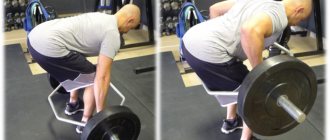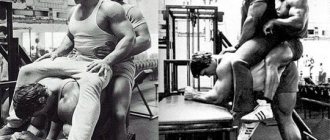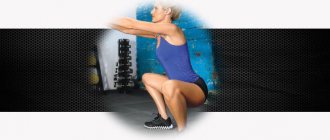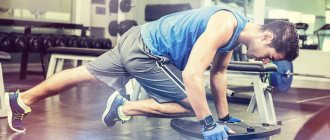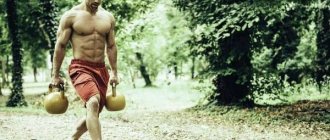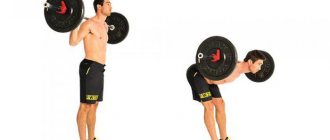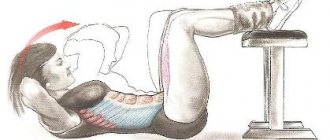Who is Svend?
Svend Odegaard Carlsen is a professional athlete in several sports. He was a powerlifter, strongman and bodybuilder. Among his achievements, it is worth noting that since 1986, the athlete has set 30 Norwegian, 3 European and 1 world records in powerlifting. In bodybuilding, Svend became Mr. Norway and took second place at the World Games. In 2001, the athlete reached the finals and won the World's Strongest Man. Svend also became Europe's Strongest Man 2001 and a three-time silver medalist at the Arnold Strongman Classic (2002-2004). After his sports career, Svend became the host and producer of the Norwegian TV show World's Strongest Man, as well as Giants Live. This man became the organizer of the "Norway's Strongest Man" tournament. The Norwegian also held a number of competitions in his homeland. And also, this strong man became famous for creating the “horizontal press” exercise in a standing position.
Svend Odegaard Carlsen photo
Benefits and disadvantages
- This exercise is not basic, but helps strengthen and increase the strength of the pectoral muscles.
- The press develops grip strength, and also increases performance in the bench press and deadlift for the back muscles.
- Some trainers recommend this type of bench press to women for effective breast recovery and tightening after childbirth.
- The Svend press creates the contours of the pectoral muscles.
- Another advantage is that it is not difficult to implement. The working weight when performing this press is much lower than that used when working with a barbell.
- Develops several muscle groups.
The disadvantage of the bench press is the load on the ligaments of the pectoral and deltoid muscles. Very often, athletes feel discomfort and pain.
Athletes who are injured or untrained will need to perform the exercise with greater caution.
Execution options
You can use dumbbells instead of weights. This variation is a little simpler than the classic one, as it requires much less effort to hold the projectiles together.
But this does not mean that your arms can dangle in different directions: dumbbells, like weight plates, should be parallel to each other and pressed tightly. Here you can afford more weight, but don’t go overboard.
You can make the bench press more difficult by using three plates instead of two. This will complicate the work of the stabilizers. But hardly anyone can afford to use pancakes heavier than 5 kg in this option.
Girls can perform this exercise lying on a bench or on the floor. Here the load is placed on the pectoral muscles alone; stabilizers and synergists are almost not involved.
However, experienced male athletes can also do the Svend bench press. In this case, you should take weights significantly greater than in the standing Svend press. This will allow you to work your chest as isolated as possible. It is more convenient to use dumbbells here.
Technique for performing the standing Svend press
- The exercise should begin from the starting position, in which the feet are shoulder-width apart, the back is straight, and the shoulders are straightened. With his palms near his chest, the athlete holds two weighting disks (they are located perpendicular to the floor, vertically).
- Please note that the discs cannot touch your chest.
- The movement is performed in a horizontal plane while exhaling. The weight comes from the chest.
- At the end point of the amplitude, the arms should not be completely straightened at the elbows. At this point, the athlete holds the load for a few seconds and then returns it to the starting position.
- Another important point when performing the exercise is to squeeze your palms as tightly as possible.
Basic mistakes
The standing barbell press is a popular and effective exercise, but athletes, especially beginners, should pay attention to some points:
- Shoulders should be thoroughly stretched. Especially before performing strength approaches. It is worth paying attention to both the general warm-up and performing approaches with light weights and gradually increasing them.
- The exercise should be performed while sitting in case of problems with the spine, and also use dumbbells.
- It is better to use the standing press as a basic exercise, but complete the workout with auxiliary exercises, for example, dumbbell presses, standing flyes, and so on.
- When working for strength, you should use a small number of repetitions, from 3 to 8, for mass - from 6 to 12, and when losing weight - from 15 or more.
The main contraindication when performing the exercise is the presence of problems with the spine. In this case, you should approach training carefully and gradually.
The most common mistakes include incorrect selection of working weight, as well as technical errors. If an athlete has difficulty performing it, it is better to consult with a more experienced athlete, or better yet, with a coach.
The standing barbell press is a basic exercise, the purpose of which is to develop the shoulders and some other auxiliary muscles. The movement is quite easy to master, but, nevertheless, you need to take the technique seriously. An important point is the correct selection of weight, number of approaches and repetitions, as well as auxiliary exercises that will help achieve better results.
Some people manage to make this movement into a parody of the bench press. They press straight up at the highest point, pushing the barbell away from the body. This turns out to be a rather traumatic variation for the shoulders, which, as the weight increases, also becomes a cause of falls. Another trajectory error is placing the barbell sharply behind the head; this option is not acceptable because it contributes to unnatural overload of the cervical spine. The third trajectory error is the “nose press,” that is, performing the exercise at half the amplitude.
Some athletes confuse this movement with the barbell overhead press due to technique. They do not press their forearms to the body, but do all the work by pushing the weight away from themselves and moving it behind the head. In this case, the elbows are spread to the sides, and the shoulders at the start are parallel to the floor. Everything would be fine if this particular initial position did not cause subacromial syndrome. Using this technique is fraught with joint pain.
Big ego
Huge weights lifted up look cool. But then treating inflammation of the ligaments and muscle tears is not at all as great. Working weights should be increased only when the movement technique allows them to be increased. Everything else is still superfluous.
Some athletes, instead of bench presses, perform a half-push, a push-up, anything to push the weight with their legs. If you can’t squeeze the barbell smoothly with your hands, you should simply reduce the weight of the weight. It is not necessary to work with the help of the body and legs.
Many people find it difficult to hold weight without losing balance during exercise. Such people should try to carefully maintain their balance by placing their weight in the middle of the arch of the foot. If this doesn’t work out and all you can do is roll, you should switch to a seated press and simultaneously work on developing the muscles of your legs and core.
This is common for all beginners. It seems to them that the program is for hacks, and they train less than everyone else in the gym. So the person begins to perform all the approaches that, in principle, he can perform. The volume increases significantly, but the intensity stops growing. The athlete experiences pain in his ligaments and joints, he does not get stronger, and his training simply becomes another attempt to overcome himself. Over time, cumulative injuries appear, and the person refuses to exercise.
Sometimes they write that movement cannot be performed only with arthrosis and osteochondrosis, but the problem is that a completely healthy person may be unable to make a movement of exactly this amplitude due to “office posture,” that is, weakness of the back muscles when the trapezius and pectoral muscles are overloaded. Over time, as your back strengthens, you will be able to lift weights overhead more effectively. Until this point, it is recommended to work with dumbbells.
The military press is a heavy compound exercise. But the norm for an amateur is to lift about half of his weight in this movement; there is no need to force things. If a person cannot lift more weight without pain, progress must be taken gradually, and be sure to actively engage in injury prevention.
The exercise should be included in your training on a regular basis, but it is better not to train your shoulders more than 2 times a week if you are a beginner, and try not to overload them even if you are an experienced athlete. It makes sense to perform either a heavy bench press or a heavy standing press, rather than constantly doing both heavy. Try to work efficiently, and you will always be able to train effectively.
The shallower the angle, the lower the load on the target pectoral muscles. The optimal inclination from the horizontal is 30 degrees, which helps to load the triceps. It is not always possible to adjust the position of the bench. If possibilities are limited, it should be taken into account that the maximum permissible angle is 60 degrees. In a high tilt, the shoulder joints experience greater tension, and the emphasis shifts to the deltoid muscle.
They must be under the bar of the projectile. You cannot move your elbows towards your legs or head.
The positive-inclined version assumes that working weights are always taken less than in the classic version. This is due to the fact that the exercise involves an isolated impact on the chest, when the assisting muscles are practically unused.
In this version of the barbell press, such a technique is cheating. It makes it easier to lift the working weight, but is unsafe. Hitting the barbell press can cause injury.
Wrist curl
Such a mistake leads to injury. Strict control over the fixation of the palms on the bar allows this to happen. They should always be in line with your forearms.
A strictly formed movement skill when performing a classic bench press usually leads to such an error. This option requires a change in direction to the collarbone area.
Bear grip
Correct technique involves using a locking overhand grip with the thumb facing the other fingers. This helps make the exercise as safe as possible. The hands should be quite tense at all times. Otherwise, the power of the pressing force will decrease.
Before proceeding to the exercise technique itself. We need to go over some technical issues. It will depend on them whether we get the desired result from the exercise. They will also help protect our shoulders from injury.
There are a number of misconceptions in bodybuilding that can lead to serious injury. One of them is where to lower the projectile on the chest or behind the head. To answer this question, we turn to anatomy, namely the structure of the shoulder joint. To make it easier to perceive the information, I advise you to pay attention to the figure below.
Read more: Pull-up program on the horizontal bar - SportWiki encyclopedia
As we see, the shoulder joint consists of two bones: the humerus and the scapula. At the end of the scapula at the junction there are two processes: the acromial and the coracoid. So, if we lower the barbell behind our head. Our humerus will move back, reducing the gap between its end (tubercle) and the acromion process.
And during the bench press, they will begin to compress the synovial bursa (bursa) and the supraspinatus muscle, which is located between them. This will lead to the so-called impingement syndrome or bursitis (inflammation of the bursa). And then, instead of having large and developed shoulders, a long and painful treatment awaits you. Therefore, do not perform barbell presses from behind your head!
Take care of your health. When performing chest presses, our elbows will be in front of our body. And during movement, the shoulder joint will work in its usual mode. Plus, the chest press is performed with a large amplitude. This means the muscles will be able to get the maximum benefit from this exercise.
Grip width
If we grab the bar very wide, our elbows will go back a lot. In this case, the shoulders will become in an anatomically uncomfortable position. That is, we again return to the same problem as lowering ourselves by the head. And, therefore, the same consequences await us. With a narrow grip, the elbows will be closer to each other.
As a result, most of the work will begin to be performed by the triceps. Unless, of course, you perform this exercise to develop the triceps brachii muscle. Then feel free to use a narrow grip. But if you want to load your shoulders, then it is also not suitable. Therefore, only a medium grip remains, slightly wider than shoulder width.
Excessive weight
This is the biggest problem that 80% of people in the gym face. Everyone wants to express themselves and show everyone that they are not timid. Therefore, when performing an overhead barbell press, athletes strive to increase the weight of the weight as quickly as possible. At the same time, completely forgetting about the execution technique and one’s own safety.
I have already said that during execution, the gaze should be directed forward and slightly upward. If you start looking at the bar while lifting. You will automatically arch your lower back. As a result, your position will become unstable and you may fall. And the consequences of such a fall can be very terrible.
Shvungs are an exercise somewhat reminiscent of a standing press. It is especially popular in CrossFit. To perform pushups, the athlete connects his legs while pressing upward. That is, he squats a little. And at the moment of straightening the legs, he presses the barbell upward. I don't argue that this is a great exercise. But before you start, you need to know a certain technique.
And if you follow everything according to the instructions, then the result will be good. When do we begin to turn the overhead barbell press into shungs? Instead of using their legs to help themselves, beginners lean back too far. This is fraught with loss of balance or spinal injury. Therefore, if you cannot completely exclude your legs from the exercise. Then reduce the weight of the barbell, or perform seated bench presses with a barbell or in a Smith machine.
Svend bench press with plate
According to some trainers, the bench press with a weight plate perfectly works the central area of the pectoral muscles. The bench press is performed identically to the standing version. When performing the Svend press, your legs can be rested on the back of the bench. The elbows in this press variation face apart during the movement and create 90 degrees from the bench.
Working muscle groups
The barbell press, performed on an incline bench, is a variation of the basic classic exercise for developing the chest muscle cell. The atypical position allows you to redistribute the load and use the upper chest to a greater extent, which is naturally much less developed. Performing this exercise allows bodybuilders to give a given muscle group more strength.
The load falls on the following muscle groups:
- clavicular region of the pectoralis major;
- anterior beam - delta;
- pectoralis minor;
- triceps;
- serrated anterior.
The standing barbell press is one of the basic exercises for the shoulder muscles. It involves several muscles at once, including the deltoids, as well as other, smaller muscles that act as stabilizers, including:
- deltoids
- triceps
- upper pectoral muscles
- levator scapulae muscles
Also, some other muscles are involved to a lesser extent, including the biceps. It turns out that when performing a movement, the athlete loads the shoulders to a greater extent, but additional load also acts on other parts.
The exercise is used both for the development of strength indicators and when working on weight, with the aim of developing the shoulder girdle. Speaking of strength, the exercise can help further progress in the bench press, as well as in weightlifting movements (clean and jerk, snatch). Movement can also be included during drying, as well as when losing weight - in various supersets and circuit training.
Muscles that work when performing a standing chest press
There are many ways to perform the exercise. Different grips, different widths of hands, their position, and trajectory of movement are possible. All this will significantly affect the muscles on which the load is shifted. An experienced athlete knows at what point to use a direct grip, at what point to use a reverse grip, as well as other features, but for beginners it is better to start by performing a standing press with a direct grip with a medium hand position. This is the most standard version of the exercise and it is the easiest to learn and the least dangerous.
The movement is carried out by the triceps, the anterior and middle heads of the deltoid muscles and partly the posterior deltoid. The muscles of the legs, buttocks, and core work as stabilizers. It is a mistake to think that the military press is an exercise that involves the calf muscles. It is a technical fault if the lifter pushes the weight upward with their legs. If performed correctly, the result will be a shwung; if performed incorrectly, it will be a mediocre imitation.
Some articles actually claim that this movement helps pump up your breasts. In fact, the pecs contract, acting as a shoulder stabilizer, and gradually stretch as the lifter lifts the bar behind his head. But the load cannot be considered sufficient for their hypertrophy. Significant confusion has also arisen because many authors of articles confuse the military-style bench press with the army one. A military-style press is usually called a bench press without supporting your legs, and a military-style press is a standing press.
It is not possible to turn off the stabilizers while standing. Therefore, it is better to leave ideas about performing this movement in Smith without implementation. The Smith machine is a fixed barbell with a trajectory that is exclusively suitable for seated overhead presses, not chest presses. Some machines simulate an elliptical path to make pressing movements more natural, but not every shoulder can work in this exact path. Therefore, it is better not to use the Smith machine option.
Read more: Rice or buckwheat in bodybuilding: which do you think is better?
Turning off stabilizers from work in basic exercises is a very irrational exercise. Athletes make a base in order to develop all the muscles of the body and activate neuromuscular connections, and not in order to later think about how exactly to adapt it so that the base is not a base.
First, let's list which muscles the bench press basically uses, and then we'll look at its variations (different grips, bench inclinations, etc.).
So, when you do a chest press, the load you receive is:
- Pectoral or pectoral muscles. Both big and small work.
- Triceps brachii muscles. The triceps always work together with the chest.
- Deltoids are the anterior bundles.
- The hands, forearms, and abs are also loaded. Stabilizer muscles that hold your body and arms in the correct position. And this is almost all the muscles, flesh down to the legs.
Now let's look at the different types of bench press in detail.
Svend bench press with dumbbell
This version of the exercise is performed technically in the same way as the others. The difference will be in the grip and the lack of pressure with your hands on the weighted discs. You can also add the movement of your elbows, which will move at an angle of 45 degrees. This variation of the Svend press is simpler, as it is much easier to hold one dumbbell. If there is no discomfort when performing the exercise, the working weight can be increased.
Lying option with two dumbbells
When pressing with two dumbbells, it is possible to carry out additional static load by pressing the dumbbells against each other. The elbows will be turned out more, and the angle from the line of the bench will be 90 degrees. Lower the dumbbells onto your chest (no need to touch it). It is important to maintain short pauses at the end points of the amplitude.
Recommendations for implementation
The Svend press is an excellent auxiliary exercise that is important at the very end of training the pectoral muscles.
- For men , a standard training regimen consisting of three to four sets of eight to twelve repetitions is suitable for performing this press.
- For girls, this exercise can be done in conjunction with a bench press. The scheme for girls is also traditional and consists of three approaches consisting of fifteen to twenty-five repetitions.
You need to perform the bench press after warm-up approaches with the lightest weight. During the warm-up, the number of repetitions can be increased :
- up to 15 – for men;
- for girls – up to 20-25.
How to properly perform the Svend press for chest relief
The Svend press exercise is aimed at growing and gaining muscle mass in the chest and triceps. It involves not only the main groups, but also stabilization ones, which allow you to maintain a vertical position of the body. It is used as a main or auxiliary, depending on the athlete’s level of training.
The invention of the Norwegian strongman at the end of the last century, unfairly forgotten, has recently been gaining a significant number of fans. This technique is suitable for amateur and professional athletes. It does not stand out as something extravagant, but it is an effective exercise.
Execution technique
Svend's training is characterized by straightening your arms in front of you with barbell discs in your palms.
At first glance, the exercise is quite simple, but following the technique of use makes it difficult not only for beginners, but also for professionals.
If the latter can use pancakes from 5 kilograms, then amateurs should start lifting smaller loads, for example, 2.5 kg. Of course, over time, both need to increase the number of discs to gain weight.
The technique for performing this press is presented as follows:
- To take the starting position, you need to press the disks (disc) tightly against one another with your palms. The arms are slightly bent at the elbow joint, the palms are located at chest level.
- After a deep inhalation and exhalation, move your hands away from you, still holding the barbell washers firmly between your palms. Push-ups occur either on a strictly horizontal plane or a slight upward diagonal. Execution requires some safety; unclenched palms can release the metal pancakes onto your legs.
- After holding for 2-3 seconds. in the indicated position, a return movement is made to the chest. After briefly fixing the hands in the starting position, the exercise will be repeated. Stopping at the start and end positions is necessary to suppress some inertia.
Read more: Exercises for the pectoral muscles for men crossovers
The training involves 10 repetitions in 3-4 approaches. It is not advisable to increase the number of repetitions by reducing the mass of the pancakes; preference should be given to the opposite - fewer iterations, but with larger weights.
The mentioned execution technique also has a strict classical version, distinguished by some complications, for example, like:
- the body in the initial position does not take a strictly vertical position, but is slightly tilted back, the palms are held in front of the chest;
- the removal of pancakes from oneself occurs only parallel to the floor, without a hint of diagonal;
- negative phase - taking the starting position.
The conservative execution of the bench press differs from the free press mainly in the position of the straightened hands. Any movement of the hands diagonally upward greatly simplifies and facilitates the method, which is considered a violation of technique, cheating.
If the workout is relatively easy, it is advisable to increase the number of plates. Such an operation will serve as a superset, but you should not overdo it with weights. Not every athlete can lift three 5 kg washers, but a beginner can suffer a shoulder injury.
Some relief from the Svend press will come from performing it in a lying position, but the effort falls only on the muscle tissue of the chest, since the stabilizing and synergistic muscles do not receive load. Perhaps a slight increase in weights will provide an opportunity to thoroughly work out the chest muscles.
- major, minor, subclavian, dentate;
- latissimus dorsi, which belongs to the posterior chest area;
- triceps brachii - extensor of the elbow joint.
The main effort is placed on the tissues of the pectoralis major muscle. Its function is to straighten and bend your arms. In this direction they are echoed by synergistic muscles: triceps, deltoid.
The latter, like the biceps and the widest, are stabilizing. Correct execution of the press technique involves the upper, lower abs, lumbar and shoulder girdle.
Listing the functioning muscles, Svend's methods are similar to push-ups, with the addition of rows of the back muscles.
This exercise serves as an excellent technique for pumping up the muscles of the upper body, as evidenced by numerous positive reviews from professionals and amateurs. The latter recommend the method for use at home, as one of the main set of exercises for the chest.
Nuances
Performing the training involves taking the starting position while holding plates in your palms. The removal of the arms from the chest occurs due to the straightening of the elbow joints, the tension of the chest tissue allows you to hold the pancakes together.
Beginners are recommended to start training with one disc, maximum 2.5 kg, pros - 5. Development of skills and muscle tissue leads to an increase in the number of discs and weight.
Also, sports medical specialists do not advise operating with weights of more than 15 kg, which is equal to three disks.
Read more: Fitness at your desk: 5 effective exercises for warming up in the office, gymnastics and fitness in the office, exercises
The Norwegian strongman press also involves some safety rules. Not recommended:
- fill the holes of the pancake with your fingers, this is fraught with possible injury and a decrease in the tension of the chest tissues;
- abduct the arms downwards, only upwards;
- fully extend the elbow joint, the positive final phase is characterized by some bending;
- perform the exercise without prior appropriate preparation or warm-up; failure to comply with the rules leads to cramps of the pectoralis major muscles;
- perform initial approaches with large weights: 2.5 kg for a beginner, 5 for a professional;
- compensate for low weights with a large number of repetitions and cheating.
It is advisable to carry out the exercise after completing a set of exercises on the chest; reducing the weight will lead to the uselessness of the exercises.
What can be replaced
The absence of a barbell at home is compensated by the dumbbell press. The difference is that the latter must be located simultaneous to one another. Holding them tightly parallel will allow the hands not to diverge to the sides, thereby ensuring the correct execution of the method.
The dumbbell exercise also allows you to add a little more weight to the dumbbells, as opposed to barbell plates. But training with pancake substitutes is fraught with giving up, which cannot even be called a free interpretation.
Conclusion
The Norwegian Svend bench press, a thing of the past, is ideal for fans of sculpted chest muscles. Its development does not involve specialized skills or long-term involvement in sports. Of course, a beginner will benefit much more than a professional bodybuilder. This is due to the fairly high preparation of the latter and the developed muscles of the pectorals.
They may include this method as an additional one. For beginners, it is more suitable as a main exercise; if you make it an additional exercise, cramps may appear. Well, happy training everyone, stay strong and functional.
